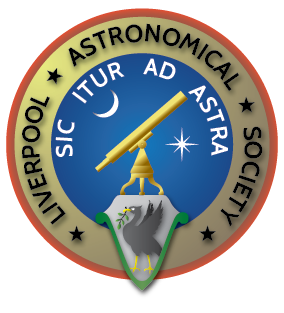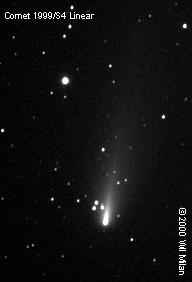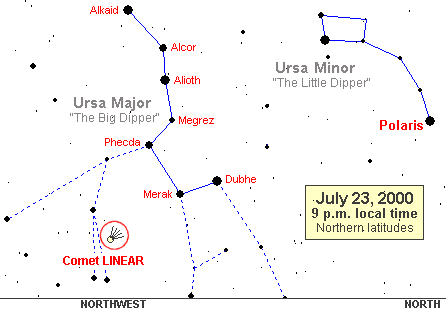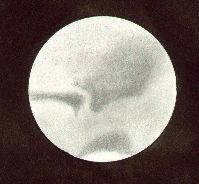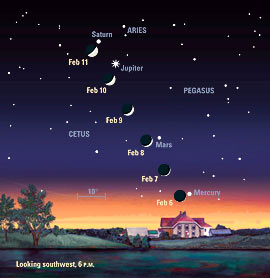Society News Headlines
- July 1st – Moon at Perigee.
- July 1st – Comet C/1994 S4 (Linear) 1.5° North of M34. (Morning Sky)
- July 1st – Mars in conjunction with the Sun.
- July 1st – Comet P/Kowal-Mrkos (2000 ET90) at Perihelion (2.547 AU).
- July 1st – Partial Eclipse of the Sun (link removed as URL is invalid) (Not seen from UK).
- July 4th – Earth at Aphelion.
- July 4th – Regulus close to crescent Moon.
- July 4th – Comet C/1999 K5 (Linear) perihelion (3.255 AU).
- July 5th – Mercury passes 5° from Venus
- July 2nd – 15th anniversary (1985) of Giotto spacecraft launch to encounter Halley’s Comet.
- July 6th – Mercury at Inferior conjunction.
- July 7th – Pex Hill open evening 7:30pm – 9:30pm.
- July 11th – Final Frontier Exbo opens at Prescot Museum. ( Until September 2000).
- July 12th – Venus at Perihelion.
- July 15th – 25th anniversary (1975) of Apollo 18 launch (Apollo-Soyuz docking).
- July 17th – 25th anniversary (1975) of Apollo-Soyuz crew handshake.
- July 15th – Moon at Apogee.
- July 16th – Vesta at opposition.
- July 16th – Total Lunar Eclipse (link removed as URL is invalid) (Not seen from UK).
- July 17th – Mercury stationary.
- July 17th – Neptune 1.2° North of Moon.
- July 18th – Uranus 1.6° North of Moon.
- July 23rd – Comet C/1999 S4 (Linear) near Earth fly-by (0.373 AU) Mag 5 or 4 in Northern Sky.
- July 23rd – Map for finding Comet Linear (link removed as URL is invalid) During July & August.
- July 26th – Comet C/1999 S4 (Linear) at perihelion (0.764 AU).
- July 26th – Saturn 2° North of Moon.
- July 27th – Neptune at Opposition.
- July 27th – Mercury at Greatest Western elongation (20°) Morning Sky.
- July 29th – Mercury 0.8° South of Moon.
- July 30th – Moon at Perigee.
- July 31st – Partial Eclipse of the Sun (link removed as URL is invalid) (Not seen from UK).
THE NIGHT SKY DURING THE MONTH OF JULY 2000
Will it be cloudy to-night?, ask the The U.K. Goverment Met Office Weather service. To make your own star chart fo your location at any time, Click Here.
The Sun and Moon
All times are in BRITISH SUMMER TIME (BST). Times For Observer in Liverpool, Merseyside, England, U.K.
Latitude 53 degs 24 mins North.
Longitude +3.0 degs West.
June 29th July 4th 9th 14th 19th 23rd 29th SUNRISE 04:47 05:50 04:55 05:01 05:08 05:15 05:23 SUNSET 21:44 21:42 21:38 21:34 21:28 21:21 21:13
| PHASES OF THE MOON DURING JULY 2000 | |||||
| NEW MOON on 1st at 20h:20m |
FIRST QUARTER on 8th at 13h:54m |
FULL MOON on 16th at 14h:56m |
LAST QUARTER on 24th at 00h:03m |
NEW MOON on 31st at 02h:26m |
|
On the 1st the Moon will be at Perigee – its closest approach to Earth in 2000 at a distance of 337,362km. On the 4th the Earth is at aphelion – the furthest distance from the Sun in its orbit – at a distance of 1.016742 Astronomical Units (1AU = 149.6km).
THE PLANETS THIS MONTH.
MERCURY.
Mercury is at inferior conjunction on the 6th but starts a morning apparition on the 24th, the details of which can be found from this TABLE.
VENUS.
Venus is starting to recover from last month’s encounter with the Sun but it will not be for a few months when it will travel far enough away from the Sun to be easily visible.
MARS.
Mars is in conjunction with the Sun on the 1st.
MARSWATCH – latest observations of the red planet.
ASTEROIDS.
- Vesta at opposition on 16th between Capricornus and Sagittarius and lies to the right of the Uranus and Neptune, (see below), close to M75 on July 1st. At just naked eye it can be seen under good clear skies.
For More information on Asteroids Click Here.
JUPITER.
Jupiter’s apparent diameter increases as it moves away from May’s Solar conjunction. At the start of the month the planet will appear 34.3 seconds of arc across whilst at the end of the month, when Jupiter is a little better placed in the morning sky (in the constellation of Taurus), it will be 36.7″ across. On the 26th (at 21h) Jupiter is 4.5° North of the crescent Moon.
Launched in October 1989, the Galileo Jupiter Probe entered orbit around the great planet on December 7th 1995. The Project Galileo Homepage will give you up-to-date information and the very latest images returned.
SATURN.
Saturn, like Jupiter is still recovering from solar conjunction in May and it will not be until the end of the month when these two planets will be favourably placed for anyone getting up to observe in the early hours of the morning. On the 26th (at 11h) Saturn is 3° North of the Moon.
URANUS and NEPTUNE.
Uranus at Mag 5.7, having overtaken slower moving Neptune some years ago now, heads slowly through the constellation of Capricornus
Neptune, like Uranus, lies in the constellation of Capricornus and is at opposition this month on the 27th at mag 7.9
Uranus Positions for the 1st July:
R.A. DEC TRANSIT TIME MAG
21h:31m:47s -15°:24':17" 03h:06m 5.7
Neptune Positions for the 1st July
R.A. DEC TRANSIT TIME MAG
20h:32m:48s -18°:35':31" 02h:07m 7.9
PLUTO.
Pluto can be found inOphiuchus, roughly between the 4th stars Zeta Ophiuchi and 20 Ophiuchi. The best time to look for the planet is around New Moon. The dates below will be a guide for planning observations.
Positions for July are when pluto's elongation angle is greater than 90°. DATE R.A. DEC TRANSIT TIME July 9th 16h:42m:29s -10°:57':51" 22h:42m July 19th 16h:41m:44s -10°:59':47" 22h:02m July 29th 16h:41m:08s -11°:02':29" 21h:22m
Pluto is best seen between June 25th – July 8th and July 24th – August 5th.
METEORS.
- Alpha-Cygnids on July 21st (6 per hour) UnFavourable Moon 5 days old.
- Capricornids on July 8th/15th and 26th Multiple radiant- (6 per hour):
- 8th – Favourable/MOON 7 days old.
- 15th – Fairly favourable/MOON 13 days old.
- 26th – Fairly favourable/MOON 23 days old.
- Delta-Aquarids on July 28th and Aug 7th. Double radiant:
- (20 per hour on 28th) Unfavourable/MOON 25 days old. (From South)
- (10 per hour on Aug 7th) Favourable/MOON 7 days old.(From North – Broad peak)
COMETS.
- Comet P/Kowal-Mrkos (2000 ET90) at Perihelion (2.547 AU).
- Comet C/1999 K5 Linearat Perihelion on July 4th at (3.255AU)
- Comet C/1999 S4 Linearat Perihelion on July 26th at (0.764AU) Near Earth flyby on July 23rd at (0.373AU) Could be naked-eye comet.
- LINEAR’s Summer Show!. from S&T.
Plus these pages will give daily and weekly reports of this and other Comets progress.
- BAA Comet Section Home Page
- Comet Web Sites.
- NASA/JPL Comet Observations Home Page.
- The Astronomer Comet Page.
OCCULTATIONS.
- July 29th at 04h:17m Disappearance of Gamma Tauri.
